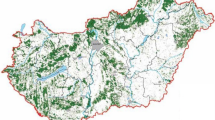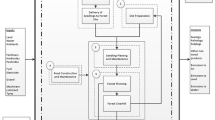Abstract
Purpose
This study aims to (1) evaluate the environmental impacts associated with the three types of raw cork produced in Portuguese cork oak woodlands (in Alentejo region) considering two alternative practices for stand establishment (plantation and natural regeneration), (2) compare the environmental impacts of raw cork production in Portuguese cork oak woodlands and in Catalonian cork oak forests, and (3) assess the influence of different allocation criteria for partitioning the environmental impacts between the different types of raw cork produced.
Methods
A cradle-to-gate approach was adopted starting with stand establishment up to cork storage in a field yard. The system boundaries include all management operations undertaken during the following stages: stand establishment, stand tending, cork stripping, and field recovery. The allocation of the environmental impacts to reproduction, second, and virgin cork was based on mass and market price criteria. An alternative allocation approach was simulated by allocating environmental impacts also to the wood produced in the cork oak stands. The impact assessment was performed using the characterization factors recommended by the International Reference Life Cycle Data System (ILCD).
Results and discussion
In Portugal, cork produced from naturally regenerated stands has a better environmental performance than cork produced from planted stands, but the differences are smaller than 10 %. Different management models of cork oak stands in Portugal and Catalonia (agro-silvopastoral system and forest system, respectively) originate different impact levels, which tend to be significantly lower in Catalonia. The environmental hot spots in the two regions are also distinct. In Catalonia, they are associated with cleaning, road maintenance, and worker and cork transport. In Portugal, they are fertilization, pruning, and cleaning. The two allocation criteria affect significantly the results obtained for virgin cork in Portugal and for virgin and second cork in Catalonia. Besides, when impacts are also allocated to wood, mass allocation should be avoided as it would not create incentives for a sustainable management of cork oak stands.
Conclusions
The environmental impact from Catalonian cork may be reduced by decreasing mechanized shrub cleaning and road maintenance operations through the introduction of livestock in cork oak forests, and also by a better planning of management operations. For the Portuguese cork, improvements may be achieved by optimizing fertilizer dosage, planting nitrogen-fixing crops and pastures that improve soil quality, avoiding unnecessary operations, improving the efficiency of management operations, and increasing tree density.







Similar content being viewed by others
References
Acácio V (2009) The dynamics of cork oak systems in Portugal: the role of ecological and land use factors. Wageningen University, Wageningen
AFN (2010) 5° Inventário florestal nacional. Autoridade Florestal Nacional, Lisbon (in Portuguese)
Almeida MH, Merouani H, Costae Silva F, Cortina J, Trubat R, Chirino E, Vilagrosa A, Khaldi A, Stiti B, El Alami SL, Vallejo VR (2009) Germplasm selection and nursery techniques. In: Aronson J, Pereira JS, Pausas JG (eds) Cork oak woodlands on the edge. Ecology, adaptive management, and restoration. Island Press, Washington DC, pp 129–137
Antunes S, Carmo MR, Gouveia F, Tavares MC, Oliveira N, Bessa P, Ferreira JG (2010) Valuation of ecosystem services at the local scale. Case study—the role of the cork oak montado at Herdade da Machoqueira do Grou (Portugal). Corticeira Amorim SGPS, SA and C.E. Liège, Santa Maria de Lamas and Paris
APCOR (2011) Estudo de caracterização sectorial 2011. Portuguese Cork Association, Santa Maria de Lamas (in Portuguese)
APCOR (2012) Cork 2012. Portuguese Cork Association, Santa Maria de Lamas
Basset-Mens C, van der Werf HMG, Durand P, Leterme P (2006) Implications of uncertainty and variability in the life cycle assessment of pig production systems. Int J Life Cycle Assess 11:298–304
Boschmonart-Rives J, Gasol MC, Sànchez S, Barriocanal C, Boada M, Garola A (2013) El valordels serveis ambientals de les suredes a Catalunya. Institut Català del Suro, Palafrugell (in Catalan)
Bugalho MN, Caldeira MC, Pereira JS, Aronson J, Pausas JG (2011) Mediterranean cork oak savannas require human use to sustain biodiversity and ecosystem services. Front Ecol Environ 9:278–286
Burriel JA, Gracia C, Ibàñez JJ, Mata T, Vayreda J (2004) Inventari ecològic i forestal de Catalunya (2000–2004). Universitat Autònoma de Barcelona, Barcelona (in Catalan)
CFC (2005) Jornades tècniques silvícoles. Consorci Forestal de Catalunya, Santa Coloma de Farners (in Catalan)
Dias AC, Arroja L (2012) Environmental impacts of eucalypt and maritime pine wood production in Portugal. J Clean Prod 37:368–376
EC (2010) International reference life cycle data system (ILCD) handbook—general guide for life cycle assessment—detailed guidance. European Commission, Joint Research Centre, Institute for Environment and Sustainability, Luxembourg
EC (2012) Characterisation factors of the ILCD recommended life cycle impact assessment methods. Database and supporting information. European Commission, Joint Research Centre, Institute for Environment and Sustainability, Luxembourg
Ecoinvent (2010) Ecoinvent database v 2.2. Swiss Centre for Life Cycle Inventories, Dübendorf
González-García S, Dias AC, Arroja L (2013) Life-cycle assessment of typical Portuguese cork oak woodlands. Sci Total Environ 452–453:355–364
Gràcia C, Sabaté S, Vayreda J, Sebastià T, Savé R, Alonso M, Vidal M (2010) Embornals. In: Llebot J (ed) Segon informe sobre el canvi climàtic a Catalunya. Institut d’Estudis Catalans and Generalitat de Catalunya, Barcelona, pp 135–182 (in Catalan)
Hauschild MZ, Goedkoep M, Guinée J, Heijungs R, Huijbregts M, Jolliet O, Margni M, De Schryver A, Humbert S, Laurent A, Sala S, Pant R (2013) Identifying best existing practice for characterization modeling in life cycle impact assessment. Int J Life Cycle Assess 18:683–697
ICNF (2013) IFN6 - Áreas dos usos do solo e das espécies florestais de Portugal continental. Resultados preliminares. Instituto da Conservação da Natureza e das Florestas, Lisbon (in Portuguese)
IPCC (2006) 2006 IPCC guidelines for national greenhouse gas inventories. Intergovernmental Panel on Climate Change, Hayama
ISO (2006) ISO 14044—environmental management—life cycle assessment—requirements and guidelines. International Organization for Standardization, Geneva
Klinglmair M, Sala S, Brandão M (2014) Assessing resource depletion in LCA: a review of methods and methodological issues. Int J Life Cycle Assess 19:580–592
Kounina A, Margni M, Bayart J-B, Boulay A-M, Berger M, Bulle C, Frischknecht R, Koehler A, Motoshita M, Núñez M, Peters G, Pfister S, Ridoutt B, van Zelm R, Verones F, Humbert S (2013) Review of methods addressing freshwater use in life cycle inventory and impact assessment. Int J Life Cycle Assess 18:707–721
Mattila T, Helin T, Antikainen R (2012) Land use indicators in life cycle assessment. Int J Life Cycle Assess 17:277–286
Paulo JA, Faias SP, Tomé M (2012) SUBER v5.0—manual do utilizador. Publications FORCHANGE, RT1/2012, Instituto Superior de Agronomia, Lisbon (in Portuguese)
Pausas JG, Marañon T, Caldeira M, Pons J (2009) Natural regeneration. In: Aronson J, Pereira JS, Pausas JG (eds) Cork oak woodlands on the edge. Ecology, adaptive management, and restoration. Island Press, Washington DC, pp 115–124
Pereira H (2007) Cork biology, production and uses. Elsevier, Amsterdam and Oxford
Pereira H, Tomé M (2004) Non-wood products. In: Jeffrey B (ed) Encyclopedia of forest sciences. Elsevier, Oxford, pp 613–620
Pereira JS, Mateus JA, Aires LM, Pita G, Pio C, David JS, Andrade A, Banza J, David TS, Paço TA, Rodrigues A (2007) Net ecosystem carbon exchange in three contrasting Mediterranean ecosystems—the effect of drought. Biogeosciences 4:791–802
Pereira JS, Bugalho MN, Caldeira MC (2008) Do sobreiro à cortiça – um sistema sustentável. Portuguese Cork Association, Santa Maria de Lamas (in Portuguese)
Pinto-Correia T, Ribeiro N, Potes J (2013) Livro verde dos montados. Instituto de Ciências Agrárias e Ambientais. Mediterrânicas, Évora (in Portuguese)
PwC/Ecobilan (2008) Evaluation of the environmental impacts of cork stoppers versus aluminium and plastic closures—analysis of the life cycle of cork, aluminium and plastic wine closures. PricewaterhouseCoopers/Ecobilan
Raddi A (2013) Full informatiu dels productes forestals a Catalunya, núm. 13. Diputació Barcelona, Barcelona (in Catalan)
Rives J, Fernandez-Rodriguez I, Rieradevall J, Gabarrell X (2011) Environmental analysis of the production of natural cork stoppers in southern Europe (Catalonia - Spain). J Clean Prod 19:259–271
Rives J, Fernandez-Rodriguez I, Rieradevall J, Gabarrell X (2012a) Environmental analysis of raw cork extraction in cork oak forests in southern Europe (Catalonia - Spain). J Environ Manage 110:236–245
Rives J, Fernandez-Rodriguez I, Rieradevall J, Gabarrell X (2012b) Environmental analysis of the production of champagne cork stoppers. J Clean Prod 25:1–13
Rives J, Fernandez-Rodriguez I, Rieradevall J, Gabarrell X (2012c) Environmental analysis of cork granulate production in Catalonia – Northern Spain. Resour Conserv Recycl 58:132–142
Rives J, Fernandez-Rodriguez I, Rieradevall J, Gabarrell X (2013) Integrated environmental analysis of the main cork products in southern Europe (Catalonia – Spain). J Clean Prod 51:289–298
Rossier D (1998) Adaptation de la method ecobilan pour la gestion environnementale de l'exploitation agricole. Service Romand de Vulgarisation Agricole, Lausanne
Silva PM, Aguiar CAS, Niemelä J, Sousa JP, Serrano ARM (2009) Cork-oak woodlands as key-habitats for biodiversity conservation in Mediterranean landscapes: a case study using rove and ground beetles (Coleoptera: Staphylinidae, Carabidae). Biodivers Conserv 18:605–619
Silva DAL, Lahr FAR, Garcia RP, Freire FMCS, Ometto AR (2013) Life cycle assessment of medium density particleboard (MDP) produced in Brazil. Int J Life Cycle Assess 18:1404–1411
Sousa EMR, Santos MNS, Varela MC, Henriques J (2007) Perda de vigor dos montados de sobro e azinho: análise da situação e perspectivas (documento síntese). Ministério da Agricultura, do Desenvolvimento Rural e das Pescas, Lisbon (in Portuguese)
Steinmann ZJN, Hauck M, Karuppiah R, Laurenzi IJ, Huijbregts MAJ (2014) A methodology for separating uncertainty and variability in the life cycle greenhouse gas emissions of coal-fueled power generation in the USA. Int J Life Cycle Assess 19:1146–1155
WWF (2006) Cork screwed? Environmental and economic impacts of the cork stoppers market. WWF Mediterranean Programme Office, Rome
Zavala MA, Zamora R, Pulido F, Blanco JA, Imbert JB, Marañon T, Castillo FJ, Valladares F (2004) Nuevas perspectivas en la conservación, restauración y gestión sostenible del bosque mediterráneo. In: Valladares F (ed) Ecología del bosque mediterráneo en un mundo cambiante. Ministerio de Medio Ambiente, EGRAF, S.A., Madrid, pp 509–529 (in Spanish)
Acknowledgments
This study has been supported by the project “ECOTECH SUDOE—International Network on LCA and Ecodesign for Eco-innovation” (SOE2/P2/E377) funded by the EU Interreg IV B Sudoe Programme and by the project “Cork Carbon Footprint: from Trees to Products” (PTDC/AGR-FOR/4360/2012) funded by Fundo Europeu de Desenvolvimento Regional (FEDER) through COMPETE—Programa Operacional Fatores de Competitividade (FCOMP-01-0124-FEDER027982) and by FCT (Science and Technology Foundation—Portugal). Thanks are also due to FCT for the postdoctoral fellowship granted to Ana Cláudia Dias (SFRH/BPD/75788/2011) and to the Galician Government for the postdoctoral fellowship granted to Sara González-García (DOG number 62, pages 9405–9410, 1 April 2013). The authors also gratefully acknowledge the group Forest Ecosystem Management under Climate Change (ForChange) of the Forest Research Centre of the Instituto Superior de Agronomia (Lisbon), in particular Margarida Tomé, Joana Amaral Paulo, and Sónia Faias, for providing simulation results from the SUBER model.
Author information
Authors and Affiliations
Corresponding author
Additional information
Responsible editor: Christian Bauer
Rights and permissions
About this article
Cite this article
Dias, A.C., Boschmonart-Rives, J., González-García, S. et al. Analysis of raw cork production in Portugal and Catalonia using life cycle assessment. Int J Life Cycle Assess 19, 1985–2000 (2014). https://doi.org/10.1007/s11367-014-0801-7
Received:
Accepted:
Published:
Issue Date:
DOI: https://doi.org/10.1007/s11367-014-0801-7




